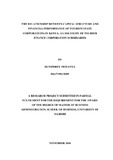| dc.contributor.author | Motanya, Humphrey | |
| dc.date.accessioned | 2017-01-20T10:04:20Z | |
| dc.date.available | 2017-01-20T10:04:20Z | |
| dc.date.issued | 2016 | |
| dc.identifier.uri | http://hdl.handle.net/11295/100430 | |
| dc.description.abstract | The choice between debt and equity financing has been directed to seek the optimal capital structure. Several studies show that a firm with high leverage tends to have an optimal capital structure and therefore it leads it to produce good performance, while the Modigliani-Miller theorem proves that it has no effect on the value of firm. The importance of these issues has only motivated researchers to examine the relationship between capital structure and firms financial performance. The purpose of the study was to investigate the relationship between capital structure and financial performance of tourism state corporations in Kenya with reference to Tourism Finance Corporation subsidiaries. The relationship between capital structure and financial performance was explained through various theories such as Trade-off Theory, Pecking Order Theory, Market Timing Theory and Modigliani and Miller. The study adopted descriptive research design where data was retrieved from the Statement of Financial Position, Income Statements and Notes of five (5) TFC subsidiaries in Kenya during the period 2011-2015. The relationship between the dependent variable and the independent variables was determined by the use of the linear regressions. The data was analysed using Statistical Package for Social Sciences (SPSS) and Microsoft (MS) Excel. The significance of capital structure variable as a predictor of financial performance was tested using the t-test. The significance of the overall model in explaining performance through the independent variables was measured through the f-test. The coefficient of determination (R2) was used to measure the strength to which independent variables explain variations in the dependent variables. The research findings established that the independent variables (Debt ratio, Asset Tangibility and asset turnover) explain and can therefore predict the financial performance of TFC subsidiaries. These variables could explain 100% of the variations in profits of TFC subsidiaries (r2=1.00). This indicated that the regression model had a very strong explanatory power as all the variability in profitability in the TFC subsidiaries could be explained by the model. The goodness of fit results of standard linear regression with ROA as the dependent variable and various determinants as predictors are reported in Table 4. The model summary is in Table 3. The model reveals that there is a statistically significant relationship between ROA and determinants (Sig. < 0.05). The model coefficients are shown in Table 5. The findings indicate that all of the indicators of ROA were significant (p< 0.05 in all cases). The study explored the relationship between ROA and various determinants by suggesting that there is a statistically significant relationship between ROA and capital structure and other determinants. Results of the study indicate that the relationship between ROA and capital structure and other determinants is statistically significant (p<0.05) for all the three predictor variables (debt ratio, asset turnover and asset tangibility). The null hypothesis was therefore rejected, meaning that there is a significant relationship between ROA of TFC Subsidiaries and capital structure, asset turnover and asset tangibility. The results of his study revealed a significant impact of all the factors of liquidity and leverage on financial performance of commercial state corporations in the tourism industry in Kenya. | en_US |
| dc.language.iso | en | en_US |
| dc.publisher | University of Nairobi | en_US |
| dc.rights | Attribution-NonCommercial-NoDerivs 3.0 United States | * |
| dc.rights.uri | http://creativecommons.org/licenses/by-nc-nd/3.0/us/ | * |
| dc.subject | The Relationship Between Capital Structure and Financial Performance of Tourism State Corporations | en_US |
| dc.title | The Relationship Between Capital Structure and Financial Performance of Tourism State Corporations in Kenya: a Case Study of Tourism Finance Corporation Subsidiaries | en_US |
| dc.type | Thesis | en_US |



